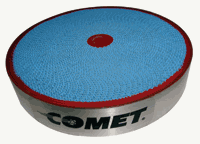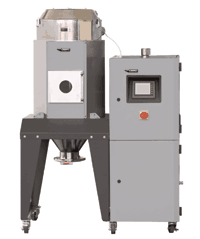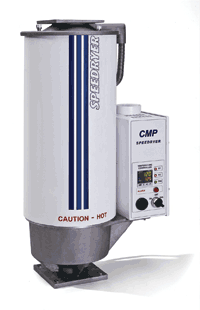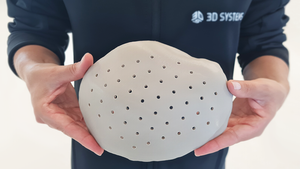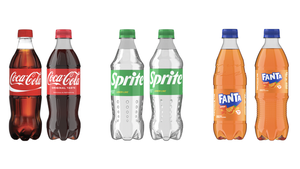In this report IMM examines the state of the technology in dryers engineered for molding medical parts in a small ISO 8—aka Class 100,000—cleanroom.
October 15, 2008
|
In this report IMM examines the state of the technology in dryers engineered for molding medical parts in a small ISO 8—aka Class 100,000—cleanroom.
Imagine that the bottom drops out of the major market a custom molder had served for years, one that involved running materials like olefins or styrene. Luckily, our imaginary molder wins a new job in a more stable market, one offering growth potential . . . you guessed it—medical. So the molder purchases a modular, soft-wall Class 100,000 (ISO 8) cleanroom, or perhaps refits a small hard-walled area right off the production floor, shells out for the cleanroom, and moves an existing 150-ton all-electric press into it.
The part is a PC housing for a medical device that requires some postmold finishing and packaging in the molder’s small cleanroom, so there’s not a lot of room left for much else in there. That’s not the biggest problem, though.
Our imaginary molder has never run a hygroscopic material, and the PC for that medical housing has to be dried.
IMM asked dryer suppliers to quote on a drying system to run PC housings for our imaginary molder’s imaginary medical device in a four-cavity mold, run in a 150-ton all-electric that’s in a crowded Class 100,000 cleanroom. Our respondents themselves clued us in to the fact that our imaginary molder’s quote probably would require anywhere from a 20- to 50-lb/hr drying system. They’ve also updated us on some of the latest state-of-the-tech dryers available today.
|
Comet Automation Systems Inc.
SDD-40U/30H-UL
Dryer type: Dehumidifying hopper
Throughput: 20-30 lb/hr
Dewpoint: -50°F (-45°C)
Cost: $6500 (50% down, net 30 days)
Our SDD-40U/30H-UL uses the energy-saving honeycomb principle and operates as a closed-loop system. Constant rotation of the honeycomb ensures that a consistently low dewpoint is achieved and constant regeneration as well. A return-air cooler is standard. It features microprocessor control with a digital display and measures just 30 by 19 by 50 inches.
This model will save you money while adding flexibility to your operations. If you want options, such as a HEPA filter or polished stainless-steel contact points, these could be added to our quote. It would be the same machine with these upgrades. We could also add a closed-loop conveying system—one including dry air conveying with loaders for two of your injection molding machines.
Combined, all of these options would add another $6000 to the package. We have considerable experience offering such dryer solutions to our customers. And we have recently assisted many molders that are moving toward Class 100,000.
|
Canam Manufactured Products Inc.
|
Speedryer SD2000 thermodynamic dryer
Dryer type: Radiant hopper
Throughput: ~50 lb/hr
Dewpoint: Inapplicable
Cost: $6195
We would recommend our thermodynamic Speedryer SD2000 dryer because it combines both ?radiant and conductive thermal energy to heat plastic pellets quickly and evenly. This results in increased vapor pressure within the pellets themselves and the rapid release of entrapped moisture. It is not a dehumidifying or hot air dryer. Incidentally, it uses just 2.0 kW of electricity, compared to 6-10 kW consumed by conventional dryers.
Since your cleanroom is crowded, the SD2000’s compact size as well as the absence of a separate air drying cabinet perfectly address your available floor space. Mounted on the hopper, it also has a zero floor space footprint. And, since the hopper contains just 20 lb of material, it’s much smaller than a more conventional 50-lb/hr dryer, which would require a 200-lb/hr-capacity hopper.
Its primary materials of construction are aluminum, stainless steel, and high-temperature epoxy, so there’s no possibility of materials contamination, And, there’s a convenient sleeve at the air exhaust, which permits attachment of a vent hose to exhaust air out of your cleanroom.
Comprehensive service and technical support is directly available from our factory. Service calls are unnecessary.
The Conair Group Inc.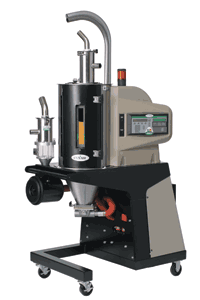 MDCW-50 Carousel Plus mobile dryer conveyor
MDCW-50 Carousel Plus mobile dryer conveyor
Dryer type: Wheel-type desiccant
Throughput: 65 lb/hr (nominal)
Dewpoint: -40°F
Cost: Not provided
Owing to the somewhat limited information on the application you are pursuing in your request for information, our recommendation is based on two assumptions: 1) We assume there is only one machine in your cleanroom, and 2) based on the machine size mentioned and limited information about the part you will be molding, we calculate your throughput requirements are probably about 50 lb/hr.
Based on these assumptions, we are recommending our MDCW-50 Carousel Plus mobile dryer conveyor. This unit should be placed outside your cleanroom with dry-air conveying to the press. This way, there is no risk of dust contamination during routine cleaning of the air filter. And by placing the dryer outside of the cleanroom, you also will avoid adding more equipment into what you’ve described as an already crowded area.
If our first assumption was incorrect and you need to dry material for more than one molding machine, and if your RFQ assumed the purchase of several similar beside-the-press units, we would suggest that you consider centralizing all of your drying in a single system outside your cleanroom.
Depending on throughput requirements, this could involve either 1) a larger MDC model, 2) a large-capacity hopper dryer (if all the machines are running the same material, or 3) a multiple-hopper Conair ResinWorks system, if you are running more than one material.
Click here to see the full quote.
Dri-Air Industries Inc. APD-3
APD-3
Dryer type: Single-hopper desiccant
Throughput: 35 lb/hr
Dewpoint: -80°F
Cost: Prices start at $7000, including microprocessor control. The closed-loop loader costs $2245.
PC is not a difficult resin to dry when compared with most resins used in the medical industry. From our testing, PC will be dry in 20 minutes in our drying systems due to the low-dewpoint air and hopper design. In sizing our systems, we would provide a hopper capacity large enough to allow you to run all medical resins, rather than one that is resin-specific. This would be true for all applications, not just medical.
Unfortunately, we do not have enough information to size the dryer we would recommend. How many pounds per hour will be processed? The throughput determines the size of the hopper and the cfm of the dryer. We recommend a 3-hour residence time and airflow close to 1 cfm per pound of resin throughput.
Even though a Class 100,000 cleanroom is not a tough application, we would suggest locating the drying system outside the room and conveying the dried material to the press. This gives you other advantages, including easier servicing and material changes, reduced energy costs associated with air-conditioning systems, and more room around the press for ancillary and postmolding equipment.
To provide the best system for your application, we would look at the average run length of your jobs to determine the percentage of downtime for material changes to the run time. A standard single-hopper design would be suggested if your run time exceeds 24 hours. For run times less than 24 hours, we would recommend a dual-hopper design to reduce press downtime, resulting in increased output of the press.
We will assume a throughput of 35 lb/hr, which is typical for this press size. Based on a specific gravity of 1.2 for PC, our 100-lb-capacity hopper will hold 120 lb of material, allowing more than 3 hours of residence time. While this is more than adequate for PC, we want a hopper capacity large enough for all medical resins. The dryer will be sized for 35 cfm and will be a desiccant-style dryer to consistently produce minimum dewpoints with maximum energy efficiency.
If the single-hopper style is selected, it will be our standard APD-3 portable dryer with a closed-loop conveying system. This model houses both the dryer and hopper on a common frame that includes the closed-loop loader. The hopper is fabricated from stainless steel and has planished automatic welds to assist in cleaning. The laser-cut access door allows easy entry to the hopper for cleaning and eliminates any gasket that might contaminate the resin. This dryer will supply -80°F or lower dewpoint air at the 250°F process temperature. Energy consumption is less than 1 kWh.
Dri-Air Industries Inc.
|
HPDII-100
Dryer type: Dual-hopper desiccant
Throughput: 35 lb/hr
Dewpoint: -80°F
Cost: Prices start at $11,000. The closed-loop loader costs $2,245
If a dual hopper is preferred, the model we would recommend for your consideration is our HPDII-100. Like the other model we suggested, the HPDII-100 is also mounted on a common frame, taking up only a 3-by-5 ft footprint. It will also provide 250°F air at -80°F dewpoint with approximately 1 kWh of energy consumption.
Our closed-loop conveying system will load the dried material without contamination from a distance of up to 300-ft from the press. The loading system includes a clean-out cycle to eliminate any material from staying in the lines and picking up moisture. The on-the-press receiver will hold enough material to last 10-to-15 minutes and is adjustable from the dryer. Because the system is closed-loop, there is nothing exhausted into the cleanroom to add to the particle count.
Options include controls, alarms, and other monitoring items. This price includes separate temperature controls for each hopper.
Our closed-loop loader can be incorporated into both of the dryers we recommend. It comes standard with a bag-style filter with blowback cleaning for each load cycle. Because the dryer is located outside of the clean room, the clean-out cycle is included.
Other options-such as an adjustable fill sensor, alarm lights, or temperature setback-may be cost-justified for the application. If the clarity of the finished part is critical, pellet de-dusting can be added to the dryer system along with a HEPA filter on the air supply to the hopper.
We have supplied hundreds of drying systems for this exact application in different sizes and for drying many different materials. If you need any additional information, please give me a call.
Maguire Products Inc.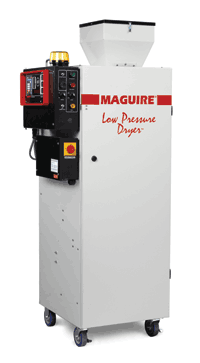 LPD-30
LPD-30
Dryer type: Vacuum
Throughput: 50 lb/hr
Dewpoint: Inapplicable
Cost: $10,000
While the high degree of energy efficiency and the elimination of desiccant are the best-known advantages of our LPD vacuum resin dryer, there are others that could also benefit your medical molding operation, including:
• Increased productivity: Many medical devices require short product runs or frequent color changes. With a much smaller batch size and much shorter drying cycle than conventional desiccant dryers, the LPD vacuum dryer can produce properly dried resin in time for each new tool setting or color change. The LPD dries in one-sixth of the time—40 minutes or less instead of the 4 hours needed with a desiccant system. Even though the vacuum dryer operates in a batch process, a model sized to accommodate anticipated molding throughput can provide an uninterrupted supply of dried resin to the molding machine.
• Enhanced quality assurance and low reject rates: Resins used for molding medical devices are often challenging to dry properly. The drying speed and efficiency of the LPD system and the small size of its batches eliminate long heat histories and reduce the risk of polymer degradation.
• Compactness: Since your molding operation will take place in a crowded cleanroom, the LPD dryer is particularly advantageous because of its compact construction. Desiccant systems require large drying hoppers because of their much longer drying time.
These advantages are in addition to a substantial reduction in energy consumption—as much as 80% when compared to older desiccant dryers now in use. Desiccant dryers are so much more energy-intensive because they flow hot, dry air over the pellets to slowly draw the moisture out, and then use desiccant to adsorb the moisture.
The large batches and prolonged drying process consume considerable energy, as does the process of regenerating the desiccant. By comparison, the LPD dryer uses vacuum to reduce the boiling point of water, to quickly turn the moisture into water vapor, and then pull the water vapor from within the pellets.
Matsui America Inc.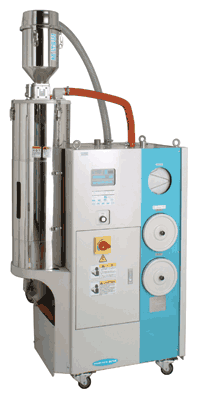 MJ3-50U
MJ3-50U
Dryer type: Desiccant rotor drying system
Throughput: 50-70 lb/hr (PC)
Dewpoint: Typically runs -50° to -60°F, continuously
Cost: $11,200 (complete with hopper and press-loading equipment)
Matsui’s Model MJ3 is a compact, portable drying and loading system. The MJ3 incorporates many Matsui technologies, which we believe to be perfect for close-tolerance cleanroom molding. For example, Matsui’s desiccant rotor system provides continuous regeneration, keeping fresh desiccant passing through the process air stream, thereby producing low and stable air ?dewpoints.
In the last few years, copycats have appeared. Unfortunately for our competition, though, Matsui has a 20-year head start. Matsui’s system was designed for plastic resin drying and refined over years to the current “state of the art.” Competitors have borrowed desiccant rotors from other industries and have tried to adapt them to plastic resin drying. However, Matsui’s system provides distinct advantages, including the following:
• 15-year desiccant rotor life: There’s no replacement or deterioration in performance over many years of use.
• 50% shorter drying times: This reduces dryer size, saves hours on changes, and lowers energy usage.
• Closed-loop, dry air conveying (with line purge) to the press: This feature improves part quality and allows the dryer to be located outside the cleanroom. • Aero Power technology: Increases clear part quality by removing dust during conveying.
• A small 46-by-25-inch footprint; stainless steel contact points; and an easy-to-clean design.
• Smart controls are available, which save energy, while protecting expensive heat-sensitive resins from overdrying.
• A waterless cooling coil with our standard, high-temperature package, which allows the dryer to be used when running low- or high-temperature materials.
• A variable hopper capacity option that allows an operator to select either 25%, 50%, 75%, or 100%, so the dryer can be used on any size job.
Motan Inc.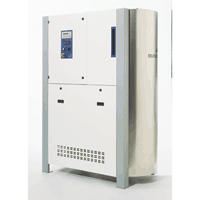 Motan Compact 50
Motan Compact 50
Dryer type: Desiccant closed-loop central
Throughput: Up to 55 lb/hr (Compact 80, up to 88 lb/hr; Compact 100, up to 220 lb/hr)
Dewpoint: -40°F (0.005% residual moisture at 50 parts/min)
Cost: $20,656 (list price)
Although many of our competitors will probably argue that our Compact dryer is a much higher-priced product than what they can recommend, you need to consider that although the initial investment may be larger, the return on investment will be much higher, while the long-term costs will be much lower.
With compressed-air drying, you would be looking at purchasing a dryer for each molding machine you need to supply, and your operating costs are going to be much higher due to the expensive compressed air that they require.
One Compact 100 dryer can supply up to four molding machines.
Also, many compressed-air dryers will require a special exhaust due to the cleanroom application, which will increase their overall price.
Thoreson-McCosh Inc.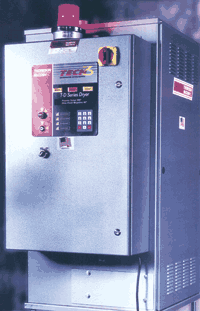 TD-24 Tech-3, TD-40 Tech-3
TD-24 Tech-3, TD-40 Tech-3
Dryer type: Desiccant
Throughput: 25 lb/hr (TD-24); 45 lb/hr (TD-40)
Dewpoint: -40°F at 300°F process
Cost: $6510 (TD-24); $7040 (TD-40)
Our Thermal-D’s closed-loop, valve-free drying system is designed and engineered to meet the toughest applications. Its triple desiccant bed design provides greater absorbing capacity and more efficient resin drying, while using considerably less energy than competitive models.
This patented design allows these dryers to use the residual regeneration heat that is recovered from the bed cool-down process to preheat the process airflow stream.
With this dryer configuration, heat energy normally wasted is reclaimed. This makes the TD the most energy-efficient dryer on the market.
The indexing of the three-bed design is done with a vertical unclamping system that eliminates unnecessary load on the rotator motor during desiccant bed rotation. This system provides complete separation of the upper and lower manifolds from the bed seals, eliminating premature seal wear, which can compromise the integrity of a closed-loop drying system.
TD dryers’ modular design allows for a number of configurations, including machine mounting, press-side, portable, or as a centralized system for medium to large process requirements.
And these dryers are fully equipped with many standard features that are optional on other competitive models. These ?include a dewpoint meter, dirty filter alarm, heater fault alarm, a blower direction indicator, and seven-day timer.
Thoreson-McCosh equipment line standouts
Material dryer unit design
• The triple desiccant bed indexing system has no rotating or moving seals and airflow valves have been completely eliminated.
• The vertical manifold unclamping system eliminates load on the rotator driver motor during desiccant bed indexing.
• Efficient static seals prevent leakage and cross air contamination between desiccant beds while eliminating rotational seal wear and lubrication problems.
• Two high-pressure blowers provide more effective process air flow to resin material and desiccant bed regeneration phase.
• Separate heater boxes for process and regeneration air flow.
• 4A 8-by-12-type molecular sieve.
Dryer unit features
• Energy-saving dewpoint switching of desiccant beds is a standard feature.
• Seven-day programmable timer.
• Process and regeneration heater bank function indicators.
• Indicators to ensure correct blower rotation for process air flow.
• Indicator lights that sense process filter “dirty” condition for easy preventive maintenance.
• Regeneration heater fault indicator.
• NEMA 12 electrical enclosure for demanding industrial applications and plant environments.
• Heat energy recovered from the regeneration cycle is reclaimed and reintroduced into the process air stream for increased energy efficiency.
• Counter flow “regen” air regenerates the desiccant bed more efficiently, ensuring a constant effective process air dewpoint of -40°F or lower.
• Regen “power saver”-a shutdown service that senses when a regeneration cycle is complete, affording huge energy savings.
• High motor amps alarm.
• Push-up motor alarm.
• Rotate motor alarm.
• Plug-flow-design hoppers with air diffuser cone located in bottom of hopper. This provides drying to the lower portion of the dry vessel, eliminating material purge and reload of undried material upon process startup.
Wittmann Inc.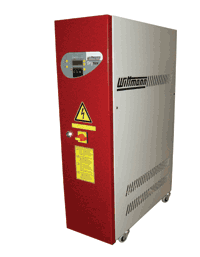 Drymax D30H (with throat-mounted hopper)
Drymax D30H (with throat-mounted hopper)
Dryer type: All-electric, dual desiccant bed
Throughput: Up to 58 lb/hr, depending on the material
Dewpoint: -76°F (0.0022% relative humidity at 200°F)
Cost: $5500, including the caster-mounted portable dryer, 70-liter hopper, lid, high-heat hose, manual discharge adapter with shutoff, and slide gate
Our Drymax D30H provides flexibility. It features an integrated side-channel blower and allows you to connect up to two material consumers in the frame underneath the drying unit. Its maintenance-free vacuum blower, powered by a three-phase motor, supplies material on demand to either the molding machine or the drying hopper.
A material level sensor in the loader triggers automatic conveying of the material, and loading is accomplished with closed-loop dry air to a receiver equipped with a glass cylinder for instantaneous visual verification.
Our D30H is easily accessible for easy cleaning and it features a single control for both drying and conveying that is equipped with an intuitive interface.—[email protected]
Contact information
Canam Manufactured Products Inc. | www.speedryer.com
Comet Automation Systems Inc. | www.cometasi.com
The Conair Group Inc. | www.conairgroup.com
Dri-Air Industries Inc. | www.dri-air.com
Maguire Products Inc. | www.maguire.com
Matsui America Inc. | www.matsuiamerica.com
Motan Inc. | www.motan.com
Thoreson-McCosh Inc. | www.thoresonmccosh.com
Wittmann Inc. | www.wittmann-ct.com
About the Author(s)
You May Also Like

